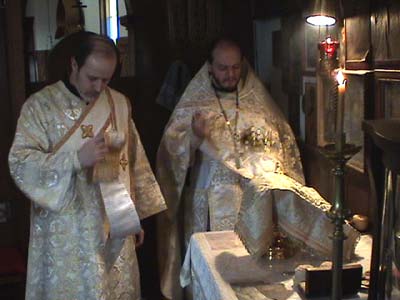Proskomedia
Bp. Alexander (Mileant)

Watch a video of the proskomedia (modem speed) for Windows Media Player or Real Video
Proskomedia is a Greek word meaning offering. The first part of the Liturgy derives its name from the early Christian custom of the people offering bread and wine and all else that was needed for the Liturgy. Therefore, each small loaf of the bread which is used in it is termed a "prosphora," another word meaning offering. This bread or prosphora must be leavened, pure, and made of wheat flour. The Lord Jesus Christ Himself, for the celebration of the Mystery of Holy Communion, used leavened, not unleavened bread, as is clear from the Greek word used in the New Testament. The prosphora must be round and formed in two parts, one above the other, as an image of the two natures of Jesus Christ, divine and human. On the flat surface of the upper part a seal of the Cross is impressed, and in the four sections thus formed are the initial Greek letters of the name of Jesus Christ, "IC XC," and the Greek word "NIKA," which mean together "Jesus Christ conquers."
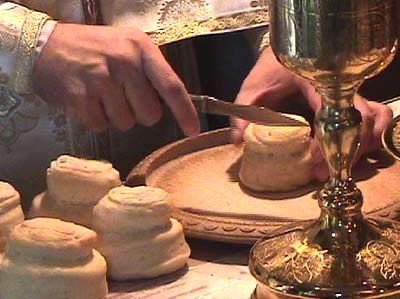
The wine used in the Mystery must be red grape wine, as this color reminds us of the color of blood. The wine is mixed with water to remind us of the pierced side of the Savior from which flowed blood and water on the Cross. Five prosphoras are used in the Proskomedia to recall the five loaves with which Christ miraculously fed the five thousand, an event which gave Him the means to teach the people about spiritual nourishment, about the incorrupt, spiritual food which is bestowed in the Mystery of Holy Communion (John 6:22-58). One prosphora, known as the Lamb, is used for Holy Communion, in accordance with the words of the Apostle: "For we, being many, are one bread and one body, for we are all partakers of that one Bread" (I Cor. 10: 17).
The Proskomedia is performed by the priest in a quiet voice at the Table of Preparation when the sanctuary is closed. During its celebration, the Third and Sixth Hours are read.
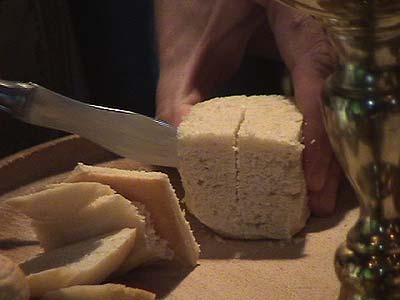
The priest takes the first prosphora and with a small spear makes the sign of the Cross over it three times, saying the words, "In remembrance of our Lord and God and Savior, Jesus Christ." The priest then cuts a cube out of the center of this prosphora with the spear (a small, wedge-shaped knife) and pronounces the words of the Prophet Isaiah: "He was oppressed, and He was afflicted, yet He opened not His mouth; He is brought as a lamb to the slaughter; and as a sheep before her shearers is dumb, so He openeth not His mouth. He was taken from prison and from judgment; and who shall declare His generation? For He was cut off out of the land of the living; for the transgressions of My people was He stricken" (Is. 53:7-8).
This cube-shaped portion of the prosphora, called the Lamb (John 1:29), is placed on the diskos, a metal plate. Then the priest cuts a cross in the bottom of the Lamb while saying the words, "Sacrificed is the Lamb of God, who taketh away the sins of the world, for the life of the world and its salvation." He then pierces the right side of the Lamb with the spear, saying the words of the Evangelist, "One of the soldiers with a spear pierced His side, and forthwith there came out blood and water. And he that saw it bore record, and his record is true" (John 19:34). In accordance with these words wine is poured into the chalice mixed with water.
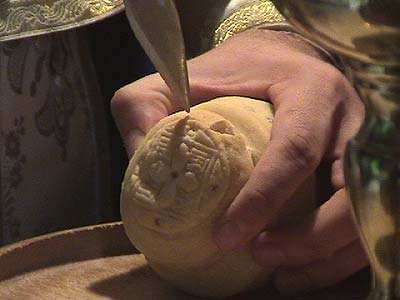
From the second prosphora, the priest cuts out one portion in honor of the Virgin Mary and places it on the right side of the Lamb on the diskos. From the third prosphora, which is called "that of the nine ranks," are taken nine portions in honor of the saints, John the Forerunner and Baptist, the prophets, the Apostles, the hierarchs, the martyrs, the monastic saints, the unmercenary physicians, the grandparents of Jesus, Joachim and Anna, the saint who is celebrated that day, the saint to whom the church is dedicated, and finally the saint who composed the liturgy being celebrated. These portions are placed on the left side the Lamb. From the fourth prosphora, portions are removed for the hierarchs, the priesthood, and all the living. From the fifth prosphora, portions are taken for those Orthodox Christians who have reposed.
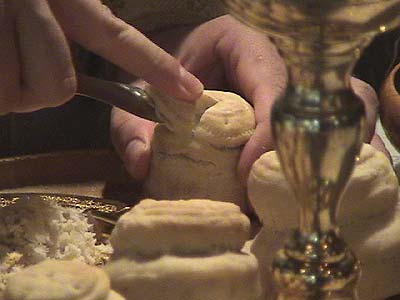
Finally, portions are removed from those prosphoras donated by the faithful, as the names of the health and salvation of living and for the repose of the dead. All these portions are placed on the diskos below the Lamb.
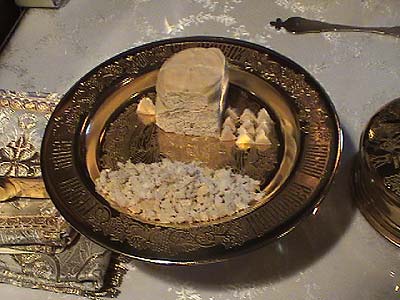
At the end of the Proskomedia the priest covers the bread with a metal asterisk (star) and then covers the diskos and chalice with special veils, censes the diskos and the chalice and prays that the Lord bless the offered Gifts and remember those who have offered them and those for whom they are offered.
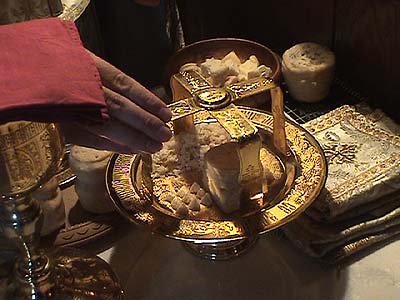
The sacred instruments used and actions performed in the Proskomedia have symbolic meanings. The diskos signifies the caves in Bethlehem and Golgotha; the star, the star of Bethlehem and the Cross; the veils, the swaddling clothes and the winding sheet at the tomb of the Savior; the chalice, the cup in which Jesus Christ sanctified the wine; the prepared Lamb, the judgment, passion, and death of Jesus Christ; and its piercing by the spear, the piercing of Christ's body by one of the soldiers. The arrangement of all the portions in a certain order on the diskos signifies the entire Kingdom of God, whose members consist of the Virgin Mary, the angels, all the holy men who have been pleasing to God, all the faithful Orthodox Christians, living and dead, and, in the center its head — the Lord Himself, our Savior. The censing signifies the overshadowing by the Holy Spirit, whose grace is shared in the Mystery of Holy Communion.
